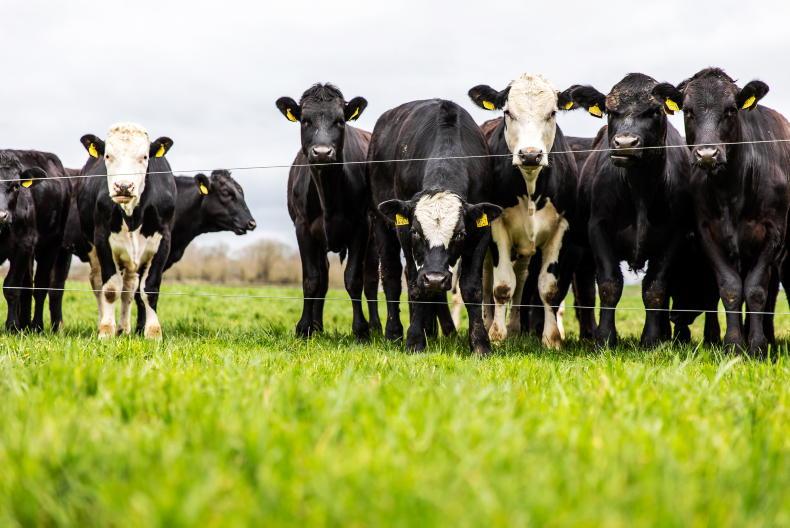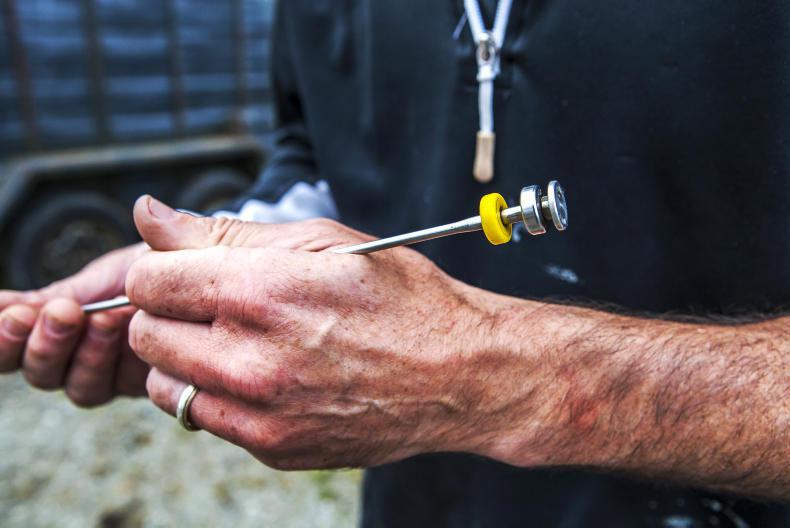The success of any dairy beef system can be defined by the management of three key factors – animal health, nutrition and genetics.
While health and nutrition must be managed and monitored on a daily basis, genetics simply has be to correct on day one.
This is why maximising the use of the best available beef genetics on the dairy herd is a key objective of the Thrive programme.
Suitable sires are selected using the ICBF dairy-beef index (DBI). The programme has set out a list of minimum requirements that sires must meet to be included on the sire list.
These include a minimum value of beef of €50 and a carcase weight figure of 5kg or more.
Table 1 outlines the top 30 of the selected bulls based on value of beef and overall DBI reliability from the programme stakeholders – Dovea Genetics, Munster AI and Progressive Genetics. The full list can be found online here.
Understanding DBI
The DBI is still a relatively new tool for farmers and it will take time for usage to increase.
From the outset, it is important to know that selecting bulls based on their overall DBI alone is almost pointless.
Within the overall DBI, there are two sub-indices:
1 Value of beef: accounts for 51% of the overall index and contains traits such as carcase weight (27%), feed intake (9%), out-of-spec: weight (7%), carcase conformation (4%), carcase fat (2%), out of spec: conformation (1%) and docility (1%).
2 Value of calving: accounts for the remaining 49% of the overall index, including calving difficulty (35%), gestation (13%) and calf mortality (1%).
Farmers need to look at the sub-indices and select bulls that suit the cows or heifers they are to be used on.
The two key parameters of calving ease and gestation length will still be the main focus point for dairy farmers and they will work within certain limits within this.

Thrive Farm. \ Philip Doyle
Breed also comes into play here, with many farmers having a preference for one breed over another based on how well calves have sold in previous years.
This is why Table 1 is ranked within breed based on value of beef.
When selecting beef sires, the objective should be to produce a calf of the highest possible beef merit within your set parameters.
Dairy farmers should work their way down the list within the chosen breed to select the highest value of beef sire that will still deliver a gestation length and calving ease that they are comfortable with.
Beef farmer feedback
Where beef farmers are buying calves year after year from the same farm, why not have the conversation about what sires are working well and what needs changing in the future.
Building good working relationships between dairy farmers and beef farmers should be the long-term goal for both the beef and the dairy farmer.
This spring, we have seen a huge interest in dairy-beef systems, with many farmers rearing calves for the first time.
Based on system economics from the Thrive programme over the last two years, the prices paid for these calves has been above what can be afforded in order to leave a positive margin at the end of the system.
Many of these calves will have no sire information recorded at all – will those beef farmers be returning to buy calves in 12 or 24 months’ time?
If dairy-beef systems are to have a sustainable future, beef farmers firstly need dairy farmers to use more high-genetic-merit beef bulls – ideally this would be through the use of AI, but, in reality, improving the DBI value of beef of stock bulls might be a more realistic target.
Secondly, farmers need to have access to the genetic information and DBI of the calf at the time of purchase.
The success of any dairy beef system can be defined by the management of three key factors – animal health, nutrition and genetics.
While health and nutrition must be managed and monitored on a daily basis, genetics simply has be to correct on day one.
This is why maximising the use of the best available beef genetics on the dairy herd is a key objective of the Thrive programme.
Suitable sires are selected using the ICBF dairy-beef index (DBI). The programme has set out a list of minimum requirements that sires must meet to be included on the sire list.
These include a minimum value of beef of €50 and a carcase weight figure of 5kg or more.
Table 1 outlines the top 30 of the selected bulls based on value of beef and overall DBI reliability from the programme stakeholders – Dovea Genetics, Munster AI and Progressive Genetics. The full list can be found online here.
Understanding DBI
The DBI is still a relatively new tool for farmers and it will take time for usage to increase.
From the outset, it is important to know that selecting bulls based on their overall DBI alone is almost pointless.
Within the overall DBI, there are two sub-indices:
1 Value of beef: accounts for 51% of the overall index and contains traits such as carcase weight (27%), feed intake (9%), out-of-spec: weight (7%), carcase conformation (4%), carcase fat (2%), out of spec: conformation (1%) and docility (1%).
2 Value of calving: accounts for the remaining 49% of the overall index, including calving difficulty (35%), gestation (13%) and calf mortality (1%).
Farmers need to look at the sub-indices and select bulls that suit the cows or heifers they are to be used on.
The two key parameters of calving ease and gestation length will still be the main focus point for dairy farmers and they will work within certain limits within this.

Thrive Farm. \ Philip Doyle
Breed also comes into play here, with many farmers having a preference for one breed over another based on how well calves have sold in previous years.
This is why Table 1 is ranked within breed based on value of beef.
When selecting beef sires, the objective should be to produce a calf of the highest possible beef merit within your set parameters.
Dairy farmers should work their way down the list within the chosen breed to select the highest value of beef sire that will still deliver a gestation length and calving ease that they are comfortable with.
Beef farmer feedback
Where beef farmers are buying calves year after year from the same farm, why not have the conversation about what sires are working well and what needs changing in the future.
Building good working relationships between dairy farmers and beef farmers should be the long-term goal for both the beef and the dairy farmer.
This spring, we have seen a huge interest in dairy-beef systems, with many farmers rearing calves for the first time.
Based on system economics from the Thrive programme over the last two years, the prices paid for these calves has been above what can be afforded in order to leave a positive margin at the end of the system.
Many of these calves will have no sire information recorded at all – will those beef farmers be returning to buy calves in 12 or 24 months’ time?
If dairy-beef systems are to have a sustainable future, beef farmers firstly need dairy farmers to use more high-genetic-merit beef bulls – ideally this would be through the use of AI, but, in reality, improving the DBI value of beef of stock bulls might be a more realistic target.
Secondly, farmers need to have access to the genetic information and DBI of the calf at the time of purchase.







 This is a subscriber-only article
This is a subscriber-only article










SHARING OPTIONS: